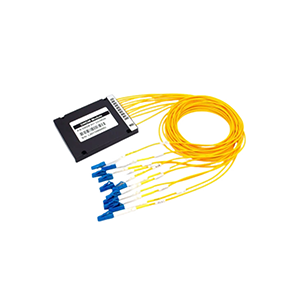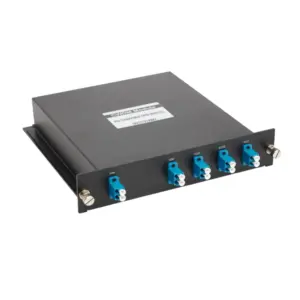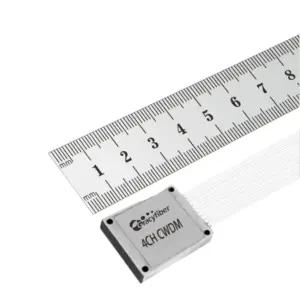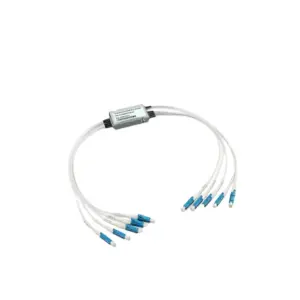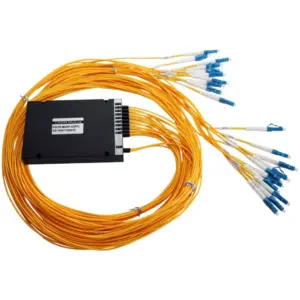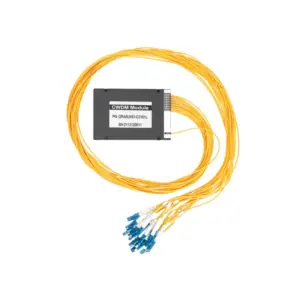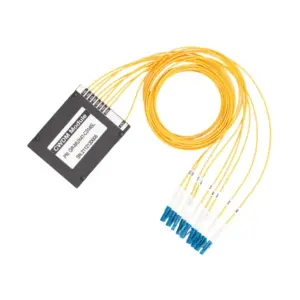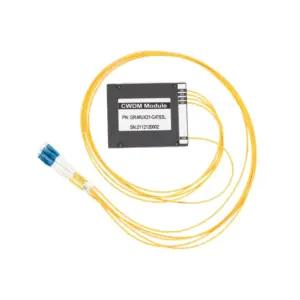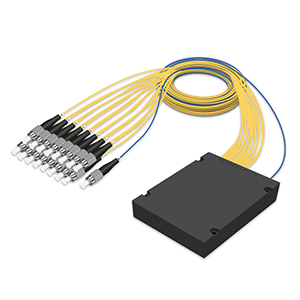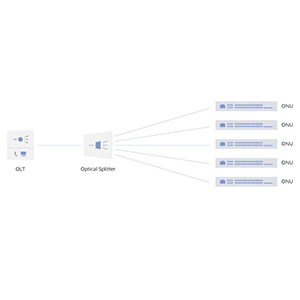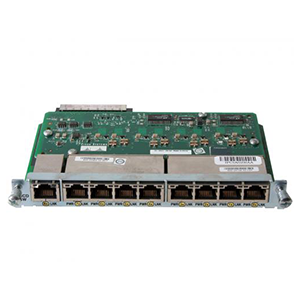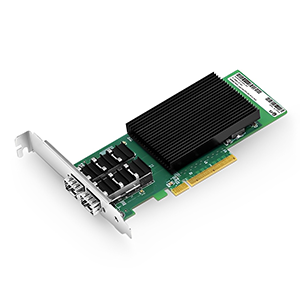Welcome to this blog! I will introduce to you the application of Wavelength Division Multiplexing (WDM for short) and Dense Wavelength Division Multiplexing (DWDM for short) technology in optical communications and compare the differences between them. By understanding the basic principles and working methods of WDM and DWDM, you will better understand their advantages in meeting different communication needs.
In the field of optical communications, WDM (Wavelength Division Multiplexing) and DWDM (Dense Wavelength Division Multiplexing) are two commonly used technologies, both of which are used to improve the capacity and bandwidth utilization of optical fiber transmission systems. Despite their similar names, there are actually some key differences between them. In this article, we will compare and contrast WDM and DWDM to help readers better understand their differences.
WDM is a technology that simultaneously transmits multiple optical signals of different wavelengths in optical fibers. It works by multiplexing signals using different wavelengths of light, combining them into a single fiber for transmission. Each optical signal has a different wavelength, so they are transmitted independently in the optical fiber without interfering with each other. WDM technology provides the ability to increase fiber transmission capacity and bandwidth utilization, but compared to DWDM technology, its wavelength spacing is larger.
DWDM is a further development of WDM technology that uses denser wavelength spacing in optical fibers to transmit optical signals. Compared with WDM, DWDM technology can multiplex signals within shorter wavelength intervals, so more optical signals can be transmitted in the same optical fiber. DWDM usually uses narrow-bandwidth optical filters to select and separate optical signals of different wavelengths to achieve higher wavelength density. This allows DWDM technology to achieve higher optical fiber transmission capacity and greater bandwidth.
Basic principles and working methods of WDM
Wavelength Division Multiplexing (WDM) is an optical communication technology that achieves high-capacity and high-bandwidth communications by simultaneously transmitting multiple optical signals of different wavelengths in optical fibers. It is based on the wavelength characteristics of light and uses optical signals of different wavelengths to be transmitted independently in optical fibers without interfering with each other.
The basic principle of the WDM system is to combine multiple optical signals into one optical fiber for transmission. Each optical signal has a different wavelength. In WDM systems, there are two common WDM types: CWDM (Coarse Wavelength Division Multiplexing) and DWDM (Dense Wavelength Division Multiplexing).
In the WDM system, the optical transmitter is a component that generates and inputs optical signals of different wavelengths into the optical fiber. Each optical transmitter corresponds to a specific wavelength, typically using a laser diode or laser to generate a high-quality optical signal. These optical signals are modulated and amplified and then transmitted to the target location through optical fibers.
Optical fiber plays the role of transmission medium in WDM system. It is a slender glass or plastic fiber with a high refractive index that can transmit optical signals. The optical fiber in the WDM system has high transparency and low loss characteristics, which can maintain the quality and intensity of the optical signal.
The optical signals transmitted in optical fibers need to be separated and demodulated, which requires the use of optical receivers. The optical receiver receives the transmitted optical signal and converts it into an electrical signal for processing. Optical receivers usually include components such as photodetectors and demodulators to convert optical signals into corresponding electrical signals.
In order to ensure that optical signals of different wavelengths can be transmitted independently, gratings or optical filters are used in WDM systems to select and separate optical signals of different wavelengths. A grating is an optical element with a periodic optical structure that can reflect or transmit optical signals to different directions according to different wavelengths. In this way, optical signals of different wavelengths can be separated and distributed into different channels.
Basic principles and working methods of DWDM
Dense Wavelength Division Multiplexing (DWDM) is a high-capacity optical communication technology based on optical fiber transmission, which is achieved by transmitting more dense wavelengths simultaneously in the optical fiber. Compared with traditional WDM technology, DWDM can multiplex optical signals within shorter wavelength intervals, thereby achieving higher optical fiber transmission capacity and larger bandwidth.
The basic principle of the DWDM system is to achieve more optical signal transmission by increasing wavelength channels. In traditional WDM systems, the wavelength spacing is usually several nanometers, while in DWDM systems, the wavelength spacing can be reduced to several nanometers or even smaller. This allows more optical signals to be transmitted in the same optical fiber, thereby increasing transmission capacity. Typically, a DWDM system can support dozens or even hundreds of wavelength channels, each channel corresponding to a specific wavelength.
DWDM systems use narrow spectral width light sources, usually using lasers or laser diodes. The optical signals generated by these light sources have smaller spectral bandwidths and can better adapt to the requirements of narrow wavelength intervals. Light sources with narrow spectrum width can provide higher wavelength density, allowing more optical signals to be transmitted in the optical fiber without interfering with each other.
In DWDM systems, high-resolution gratings (or optical filters) play a key role. Gratings have periodic optical structures that can select and separate optical signals of different wavelengths. Due to the small wavelength spacing in the DWDM system, the grating needs to have high resolution in order to accurately separate optical signals of different wavelengths. High-resolution gratings enable more precise optical signal processing and reduce crosstalk and interference between wavelengths.
DWDM systems can also be equipped with optical amplifiers to enhance the strength of the transmitted signal. Optical amplifiers can amplify optical signals during their transmission, thereby compensating for losses in optical fiber transmission. This extends the transmission distance and improves the performance of the system.
The difference between WDM and DWDM
WDM (Wavelength Division Multiplexing) and DWDM (Dense Wavelength Division Multiplexing) are two optical communication technologies. They have some differences in system capacity, spectrum efficiency, wavelength spacing and fiber utilization. Here’s how they compare:
-
System capacity: DWDM has higher system capacity than traditional WDM technology. WDM systems usually support a small number of wavelength channels (usually several to a dozen wavelengths), while DWDM systems can support many more wavelength channels (usually tens to hundreds of wavelengths). Therefore, the DWDM system can transmit more optical signals in the same optical fiber and achieve greater system capacity.
-
Spectral efficiency: DWDM has higher spectral efficiency than WDM. In WDM systems, the wavelength intervals are usually large, so the number of wavelengths that can be reused within a unit spectrum range is limited. In the DWDM system, the wavelength spacing is smaller, and more wavelengths can be reused within the same spectrum range, thereby improving spectrum efficiency.
-
Wavelength spacing: The wavelength spacing in WDM systems is large, usually on the order of several nanometers. The wavelength spacing in the DWDM system is smaller, usually on the order of several nanometers or even smaller. The reduction of the wavelength spacing in the DWDM system allows more wavelengths to be transmitted in the optical fiber, thus increasing the system capacity and bandwidth.
-
Fiber utilization: DWDM system has higher fiber utilization than WDM system. Since DWDM systems transmit more wavelengths in the same optical fiber, fiber utilization is higher. This means more data can be transmitted over fiber optics, increasing the overall efficiency of the system.
DWDM has the following advantages over traditional WDM technology:
-
Higher density: DWDM systems can achieve higher wavelength density, allowing more wavelength channels to be transmitted in the optical fiber. This enables DWDM systems to meet growing bandwidth requirements and provide higher transmission capacity.
-
Capacity scalability: Because the DWDM system supports more wavelength channels, it has better capacity scalability. If increased transmission capacity is required, more wavelength channels can simply be added without replacing the entire system.
WDM and DWDM differ in terms of system capacity, spectrum efficiency, wavelength spacing and fiber utilization. Compared with traditional WDM technology, DWDM has higher density and capacity scalability, can meet the growing bandwidth requirements and provide higher transmission capacity.
Application scenarios of WDM vs DWDM
WDM (Wavelength Division Multiplexing) and DWDM (Dense Wavelength Division Multiplexing) are two optical communication technologies that are widely used in different application scenarios. They can be selected and used according to specific communication needs. The following are their application cases and selection in different application scenarios:
Long distance transmission:
- WDM: WDM technology can be used when medium and long-distance transmission is required. For example, in a metropolitan area network or wide area network, WDM can combine multiple optical signals onto one optical fiber for transmission to achieve high-bandwidth long-distance communication.
- DWDM: For longer-distance transmission requirements, especially when spanning continents or large-scale network interconnection, DWDM technology is more suitable. The DWDM system can transmit more wavelength channels in the optical fiber, providing greater transmission capacity and higher bandwidth to meet the needs of long-distance transmission.
Data center interconnection:
- WDM: In data center interconnection, WDM technology is often used for short-distance transmission. For example, optical signals between different data centers are merged onto one optical fiber to achieve high-density and high-bandwidth data transmission.
- DWDM: DWDM technology is more suitable for the interconnection needs of large data centers, especially when it is necessary to handle large amounts of data traffic and achieve high-speed connections. DWDM systems can provide higher transmission capacity and more wavelength channels to meet the high-speed interconnection needs between data centers.
Optical Network:
- WDM: In optical networks, WDM technology is usually used to build point-to-point or point-to-multipoint optical links. For example, in optical fiber backbone networks, WDM can multiplex and transmit multiple optical signals to achieve high-speed broadband data transmission.
- DWDM: DWDM technology is more suitable for large-scale optical networks, especially when it is necessary to support complex topology, multi-path and high-capacity transmission. DWDM systems can provide more wavelength channels and higher fiber utilization to meet the needs of complex optical networks.
Selecting WDM or DWDM technology to meet specific communication needs depends on the following factors:
- Transmission distance: For short-distance transmission, WDM technology may be sufficient to meet the needs; while for long-distance transmission, DWDM technology is more suitable.
- Bandwidth requirements: If higher bandwidth and transmission capacity are required, DWDM technology is usually a better choice.
- System cost and complexity: DWDM systems are generally more expensive and complex than WDM systems. Therefore, for smaller-scale or budget-constrained applications, WDM technology may be more suitable.
In summary, the choice of WDM or DWDM technology depends on factors such as transmission distance, bandwidth requirements, system cost and complexity. Depending on the specific communication needs and application scenarios, appropriate technologies can be selected to meet the communication requirements.
Summary
Thank you for reading this blog. I hope you will have a deeper understanding of the applications and differences between Wavelength Division Multiplexing (WDM) and Dense Wavelength Division Multiplexing (DWDM) technologies in optical communications. . WDM and DWDM technologies realize high-bandwidth and high-capacity communication systems by simultaneously transmitting multiple optical signals of different wavelengths in optical fibers.
WDM FAQ
Lorem ipsum dolor sit amet, consectetur adipiscing elit, sed do eiusmod tempor incididunt ut labore et dolore magna aliqua. Ut enim ad minim veniam, quis nostrud exercitation ullamco laboris nisi ut aliquip ex ea commodo consequat.
Lorem ipsum dolor sit amet, consectetur adipiscing elit, sed do eiusmod tempor incididunt ut labore et dolore magna aliqua. Ut enim ad minim veniam, quis nostrud exercitation ullamco laboris nisi ut aliquip ex ea commodo consequat.
WDM related products
Our products provide advanced WDM and DWDM technical support, bringing huge improvements to your communication network. Whether you choose WDM or DWDM, we will provide you with efficient and reliable communication connections to meet your growing communication needs.

